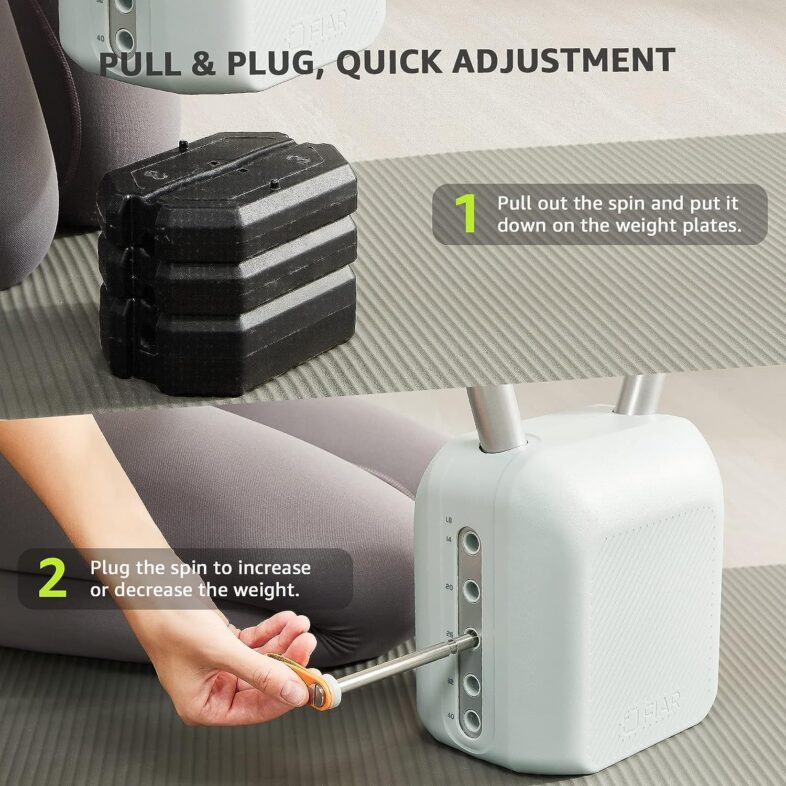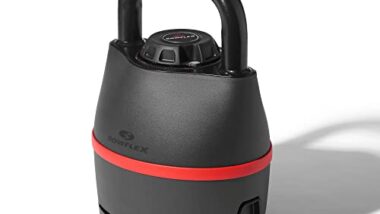How To Adjust An Adjustable Kettlebell
In this article, you will discover the simple yet effective steps How To Adjust An Adjustable Kettlebell. With the rise in popularity of kettlebell workouts, it’s essential to know how to get the most out of this versatile piece of equipment.
Whether you’re a beginner or an experienced kettlebell enthusiast, being able to adjust the weight to suit your fitness level is crucial. So, grab your kettlebell, and let’s get started on making the necessary adjustments for an optimal workout experience.
Choosing the Right Adjustable Kettlebell
When it comes to choosing the right adjustable kettlebell, it’s important to consider your fitness goals. Are you looking to build strength, increase endurance, or improve overall fitness? Understanding your goals will help you determine the weight range needed for your kettlebell. Consider your current fitness level and any specific exercises you plan to do with the kettlebell.
In addition to considering your fitness goals, it’s important to check for adjustability options when choosing an adjustable kettlebell. Some kettlebells come with a variety of weight plates that can be easily added or removed, allowing you to customize the weight according to your needs. Others may have a dial or locking mechanism that allows for quick and easy weight adjustments. Assess which type of adjustability option would work best for you.
Lastly, consider the handle design of the adjustable kettlebell. The handle is an important factor to consider as it contributes to your comfort and grip during workouts. Look for a kettlebell with a handle that is comfortable to hold and provides a secure grip. A well-designed handle will allow you to perform exercises with ease and maintain proper form.
Understanding the Adjustment Mechanism
Before you start adjusting your kettlebell, it’s important to understand the different types of adjustable kettlebells available. There are two main types: plate-loaded kettlebells and dial-adjustable kettlebells. Plate-loaded kettlebells require the addition or removal of weight plates, while dial-adjustable kettlebells have a dial or locking mechanism that allows for quick weight adjustments. Familiarize yourself with the mechanism of the kettlebell you have to ensure you can make proper adjustments.
Once you understand the type of adjustable kettlebell you have, it’s important to identify the specific adjustment points. This will vary depending on the kettlebell’s design. Look for clear markings or indicators that show where the weight plates can be added or removed. Understanding the specific adjustment points will make the process easier and ensure proper weight distribution.
Preparing the Kettlebell for Adjustment
Before you start adjusting the weight of your kettlebell, there are a few steps you need to take to prepare it. First, ensure that the kettlebell is empty. Remove any weight plates or attachments that may already be in place. This will provide a clean slate for you to adjust the weight according to your needs.
Next, inspect the adjustable components for any damage. Check for any cracks, dents, or loose parts that may affect the functionality of the adjustable kettlebell. It’s important to use a kettlebell in good condition to ensure your safety during workouts.
After inspecting the kettlebell, clean and dry it thoroughly. Use a mild detergent and water to clean the kettlebell, paying special attention to the adjustable components. Dry the kettlebell completely to prevent any rusting or damage to the weight plates or locking mechanism.
Finally, find a suitable location for adjusting your kettlebell. Make sure you have enough space to move around and access the weight plates. Choose a flat surface that provides stability and a clear view of the adjustment points.
Adjusting the Weight
Once you have prepared your kettlebell, it’s time to adjust the weight according to your needs. Before you begin, it’s important to read the manufacturer’s instructions. Different kettlebells may have specific guidelines on how to adjust the weight safely and effectively. Familiarize yourself with these instructions to ensure you are using the kettlebell correctly.
To start adjusting the weight, select the desired weight you want to work with. Determine the number of weight plates you need to add or remove to achieve the desired weight. Carefully remove or insert the weight plates, making sure they are properly aligned with the adjustment points. Double-check that each weight plate is securely in place before continuing.
Once you have added or removed the weight plates, it’s important to secure them in place. This can be done through a locking mechanism or by tightening the weight plates with a tool, depending on the type of adjustable kettlebell you have. Ensure that all weight plates are securely fastened to prevent any accidents or shifting of weight during your workout.
Checking the Stability and Balance
After adjusting the weight of your kettlebell, it’s crucial to check its stability and balance. This is essential for your safety and to ensure proper form during exercises. Start by ensuring that all weight plates are properly inserted into their respective adjustment points. Check each weight plate individually to make sure it is securely in place.
Next, verify that the locking mechanism, if applicable, is engaged. This will prevent any accidental movement or shifting of weight during your workouts. If you’re using a dial-adjustable kettlebell, ensure that the dial is properly set and locked in place.
To test the stability and balance of the kettlebell, gently rock it in different directions. A well-adjusted kettlebell should feel stable and evenly distributed. If you notice any wobbling or uneven weight distribution, double-check the adjustment of the weight plates and ensure they are all securely fastened.
Using Proper Form and Technique
Now that you have adjusted the weight and ensured the stability and balance of your kettlebell, it’s important to focus on using proper form and technique during your workouts. This will help you maximize the benefits of kettlebell exercises and reduce the risk of injury.
If you’re new to kettlebell training, start by learning the basic kettlebell exercises. These include movements like the kettlebell swing, goblet squat, and Turkish get-up. Familiarize yourself with the proper form and technique for each exercise to ensure you are performing them correctly.
When starting out, it’s recommended to use lighter weights until you are comfortable with the movements and have mastered the proper form. This will help you avoid unnecessary strain or injury. Gradually increase the weight as you gain strength and confidence in your abilities.
Maintaining a proper grip and body alignment is key to using the kettlebell effectively. Keep a firm grip on the handle, ensuring your fingers are comfortably wrapped around it. Maintain a neutral spine and engage your core muscles to support your body during the exercises.
Maintaining and Storing the Adjustable Kettlebell
To prolong the lifespan of your adjustable kettlebell and ensure its optimal performance, it’s important to follow proper maintenance and storage practices. Regularly inspect the kettlebell for any wear and tear. Check for any cracks, loose parts, or signs of damage. Address any issues promptly to prevent further damage or accidents.
After each use, clean and sanitize the kettlebell to remove any dirt, sweat, or bacteria that may have accumulated. Use a mild detergent and water to clean the kettlebell thoroughly, paying attention to the handle and adjustable components. Dry it completely before storing to prevent any rusting.
When it comes to storing your adjustable kettlebell, choose a dry and safe place. Excessive humidity can lead to rusting, and extreme temperatures can affect the functionality of the weight plates or locking mechanism. Keep the kettlebell in a location where it won’t be exposed to any potential hazards or damage.
Tips for Effective Kettlebell Workouts
To get the most out of your kettlebell workouts, consider the following tips:
- Warm up before each workout to prepare your muscles and joints for the exercises.
- Focus on proper breathing techniques, inhaling during the eccentric phase and exhaling during the concentric phase of each exercise.
- Gradually increase the intensity and duration of your workouts to challenge your body and progress.
- Listen to your body and take breaks when needed. Pushing yourself too hard can lead to injury and setbacks.
Common Mistakes to Avoid
To ensure a safe and effective kettlebell workout, avoid the following common mistakes:
- Using incorrect technique: This can lead to muscle imbalances, strain, and injury. Take the time to learn and practice proper form for each exercise.
- Neglecting proper warm-up and cooldown: Skipping these important steps can increase the risk of injury and leave you feeling sore and stiff.
- Using excessive weight beyond your capability: Gradually progress to heavier weights as your strength and technique improve. Using weights that are too heavy can compromise your form and increase the risk of injury.
- Overlooking regular maintenance and inspection: Neglecting to check for any damage or wear and tear can compromise the safety and functionality of your kettlebell.
Seeking Professional Guidance
If you’re new to kettlebell training or want to take your workouts to the next level, consider seeking professional guidance. Consulting a certified kettlebell instructor can provide you with personalized guidance and ensure you are using proper form and technique.
Attending kettlebell workshops or classes is another great way to learn from experienced instructors and connect with fellow kettlebell enthusiasts. These structured sessions can help you refine your skills and learn new exercises and techniques.
If you prefer one-on-one guidance, consider working with a personal trainer. They can create a customized kettlebell program tailored to your goals and guide you through proper form and technique.
Lastly, reputable online resources can also provide valuable information and instructional videos to help you improve your kettlebell workouts. Look for reliable sources that provide evidence-based information from qualified experts.
Remember, adjusting an adjustable kettlebell is just the first step. Using proper form and technique, maintaining and storing the kettlebell correctly, and seeking professional guidance when needed will ensure you get the most out of your kettlebell workouts. Enjoy your training and stay motivated on your fitness journey!



